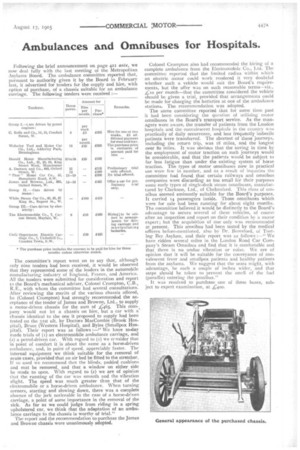Ambulances and Omnibuses for Hospitals.
Page 15

If you've noticed an error in this article please click here to report it so we can fix it.
Following the brief announcement on page 425 ante, we now deal tully with the last meeting ot the Metropolitan Asylums Board. The ambulance committee reported that, pursuant to authority given it by the Board in February last, it advertised for tenders for the supply and hire, with option of purchase, of a chassis suitable for an ambulance carriage. The following tenders were received :
The committee's report went on to say that, although only nine tenders had been received, it would be observed that they represented some of the leaders in the automobile manufacturing industry of England, France, and America. All the tenders were submitted for consideration and report to the Board's mechanical adviser, Colonel Crompton, C.B., R.E., with whom the committee had several consultations. After reviewing the merits of the various chassis offered, be (Colonel Crompton) had strongly recommended the acceptance of the tender of James and -Browne, Ltd., to supply a motor-driven chassis for the sum of L465. This company would not let a chassis on hire, but a car with a chassis identical to the one it proposed to supply had been tested on the 31st ult. by Doctors MacCombie (Brook Hospital), Bruce (Western Hospital), and Byles (Smallpox Hospital), Their report was as follows :—" We have to-day made trials of (1) an electromobile ambulance carriage, and (2) a petrol-driven car. With regard to (/) we ccnsider that in point of comfort it is about the same as a horse-driven ambulance, and, in point of speed, appreciably faster. The internal equipment we think suitable for the removal of acute cases, provided that an air bed be fitted to the stretcher. If so used we recommend that the blinds, padded cushions and mat be removed, and that a window on either side be made to open. With regard to (2) we are of opinion that the running of the car was smooth and the vibration slight. The speed was much greater than that of the electromobile or a horse-driven ambulance. When turning corners, starting and slowing down, there was a complete absence of the jerk noticeable in the case of a horse-driven carriage, a point of some importance in the removal of the sick. As far as we could judge from riding in a spring upholstered car, we think that the adaptation of an ambulance carriage to the chassis is worthy of trial."
The report and the recommendation to purchase the James and Browne chassis were unanimously adopted.
Colonel Crompton also had recommended the hiring of a complete ambulance from the Electromobile Co., i.td. The committee reported that the limited radius within which an electric motor could work rendered it very doubtful whether such a vehicle would suit the Board's requirements, but the offer was on such reasonable terms—viz., ;Cm per month—that the committee considered the vehicle should be given a trial, provided that arrangements could be made for charging the batteries at one of the ambulance stations. The recommendation was adopted.
The same committee reported that for some time past it had been considering the question of utilising motor omnibuses in the Board's transport service. As the managers were aware, the transfer of patients from the London hospitals and the convalescent hospitals in the country was practically of daily occurrence, and less frequently imbecile patients were transferred. The shortest of these journeys, including the return trip, was 18 miles, and the longest over 8o miles. It was obvious that the saving in time by the employment of motor traction on such journeys would be considerable, and that the patients would be subject to far less fatigue than under the existing system of horse traction. The types of motor omnibuses now in practical use were few in number, and as a result of inquiries the committee had found that certain railways and omnibus companies were discarding as too small for their purposes some early types of single-deck steam omnibuses, manufactured by Clarkson, Ltd., of Chelmsford. This class of omnibus seemed eminently suitable for the Board's purposes. It carried 14 passengers inside. Those omnibuses which were for sale had been running for about eight months. The committee believed it would be distinctly to the Board's advantage to secure several of these vehicles, of course after an inspection and leport on their condition by a motor expert; but the acquisition of one only was recommended at present. This omnibus had been tested by the medical officers before-mentioned, also by Dr. Berestord, of Tooting Bee Asylum, and their report was as follows :—" We have ridden several miles in the London Road Car Company's Steam Omnibus and find that it is comfortable and that there is no undue vibration or noise. We are of opinion that it will be suitable for the conveyance of convalescent fever and smallpox patients and healthy patients from the asylums. We suggest that the seats might, with advantage, be each a couple of inches wider, and that steps should he taken to prevent the smell of the fuel (paraffin) entering the omnibus."
It was resolved to purchase one of these buses, subject to expert examination, at £400.
















